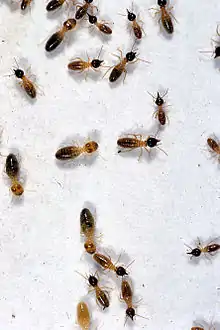Nasutitermes triodiae
Nasutitermes triodiae is a grass-eating species of snouted harvester termite that occurs in the Northern Territory of Australia. It is known as the Cathedral Termite because of the very high mounds it constructs. It is also sometimes referred to as the spinifex termite, since it is found in the spinifex grasslands.[1]
| Nasutitermes triodiae | |
|---|---|
 | |
| Mound of Cathedral Termite, Nasutitermes triodiae | |
| Scientific classification | |
| Kingdom: | |
| Phylum: | |
| Class: | |
| Order: | |
| Family: | |
| Genus: | |
| Species: | Nasutitermes triodiae |
| Binomial name | |
| Nasutitermes triodiae | |

Cathedral termite mounds can reach an immense size quite rapidly. Mounds appeared on a Darwin River property 85 km southwest of Darwin after mowing of grassland ceased in mid-2014. A photo taken in January 2015 by Denise Goodfellow shows no termite mounds. By January 2016 there were a few mounds some a metre in height and by late 2018 there were 39, the tallest over four metres. In late October, 2019 this mound grew a metre in height in less than a week (Michael Stott, personal comment).
The mounds are growing on a substrate of fine sand/clay/silt mix (information provided by Professor Emeritus Martin Williams) over a bedrock of laterite. Dominant grasses present include Themeda triandra (Kangaroo Grass) and in the early Wet Season, Alloteropsis semialata (Cockatoo Grass). There is no 'spinifex' (Triodiae sp.) in the vicinity.
In mid-September 2019, these mounds were the subject of a research project. Results will be forthcoming.
References
- "BBC - Earth - 12 nests you won't believe were made by insects". January 13, 2016. Retrieved January 14, 2016.